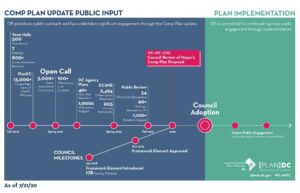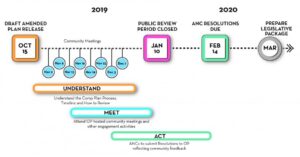In this post, we will explore why DC’s “affordable” housing is not affordable for most working families and residents in DC.
In DC, “affordability” presents us a math problem that most people just don’t have the time or care to figure out. We hear the word “affordable” and everything must be all good. It’s not.
What is DC’s affordability problem?
The AMI is based on the incomes of working residents in the DMV region including the District of Columbia, Northern Virginia, and parts of Maryland.
In fact, the AMI includes incomes of some of the wealthiest people in the United States like residents in Fairfax County, VA and Montgomery County, MD. And more and more wealthy people are moving into the region and they are making more and more take home money every year.
Thus in 2023-2024, the AMI for our region is $152k/yr for a family of four. For a household of one (a single person), the AMI is $106k/yr.

Source: Webpage, “2023-2024 Inclusionary Zoning Maximum Income, Rent and Purchase Price Schedule” at the DC Department of Housing and Community Development (DHCD) Wesbite, https://dhcd.dc.gov/publication/2023-2024-inclusionary-zoning-maximum-income-rent-and-purchase-price-schedule
There are three critical issues (among others) using DMV’s AMI to calculate DC’s “affordable” housing:
The AMI increases annually, thus DC’s overall affordability decreases each year.
- In 2017, a single person household making $62k/yr could qualify for one of DC’s “affordable” studio/one bedrooms. Now in 2023-24, an individual making $85k/yr can qualify for an “affordable” studio/one-bedroom housing unit in DC. Thus, the limited pool of “affordable” units becomes less and less accessible by lower-income residents.
Source: Testimony in Zoning Case 23-02, Exhibit No. 558, at page 4, by Save DC Public Land, citing to the DHCD affordability matrices from 2017 and 2022 contrasting annually decreasing affordability, https://app.dcoz.dc.gov/CaseReport/ViewExhibit.aspx?exhibitId=331135
The city is producing housing that is unaffordable for most people and non-existent for families, yet calling it all affordable housing.
- More than half of DC’s “affordable” units are for individuals making 80% of the AMI and by the math problem this mean “affordable” housing for individuals making $85k/yr.
- The vast majority of “affordable” units in DC are for single residents (studios/one-bedrooms), with almost no units for families of three or more.
Source: Report, “Inclusionary Zoning Annual Report for Fiscal Year 2022” published by the DC Department of Housing and Community Development (DHCD) and submitted to the DC Ctiy Council by DC Mayor Muriel Bowser on April 12, 2023, https://dhcd.dc.gov/node/1655696
The AMI doesn’t consider DC’s minimum wage or immense racial wealth gap.
- DC residents making the minimum wage are making about $33k/yr.
- The median household income for DC’s white residents, at $149k/yr, is over three times higher than the median income of DC’s Black residents, which is $50k/yr (pre-pandemic).
Source: Report, “D.C. Racial Equity Profile for Economic Outcomes” published by the DC Council Office on Racial Equity and the DC Policy Center dated January 2021, https://www.dcracialequity.org/dc-racial-equity-profile















